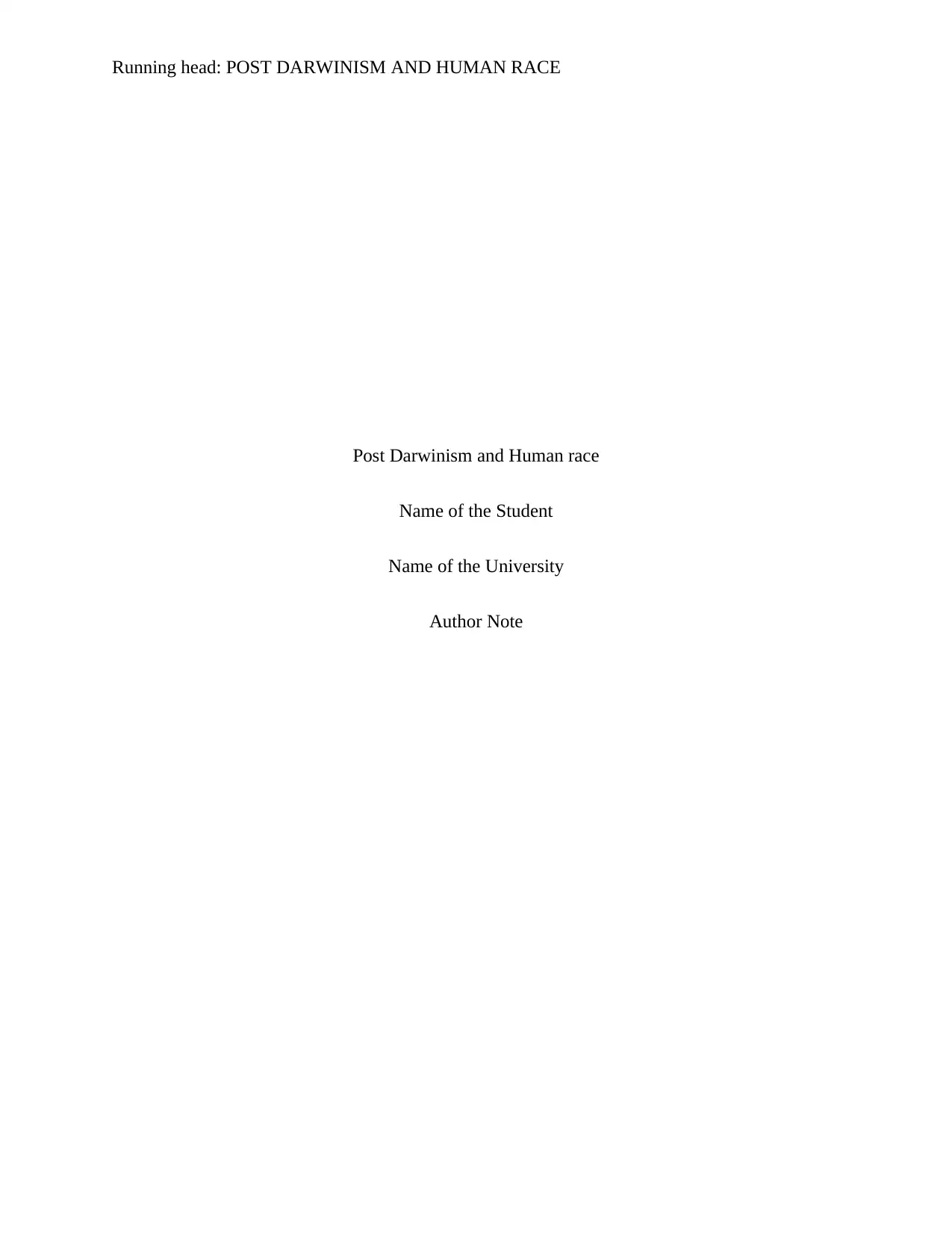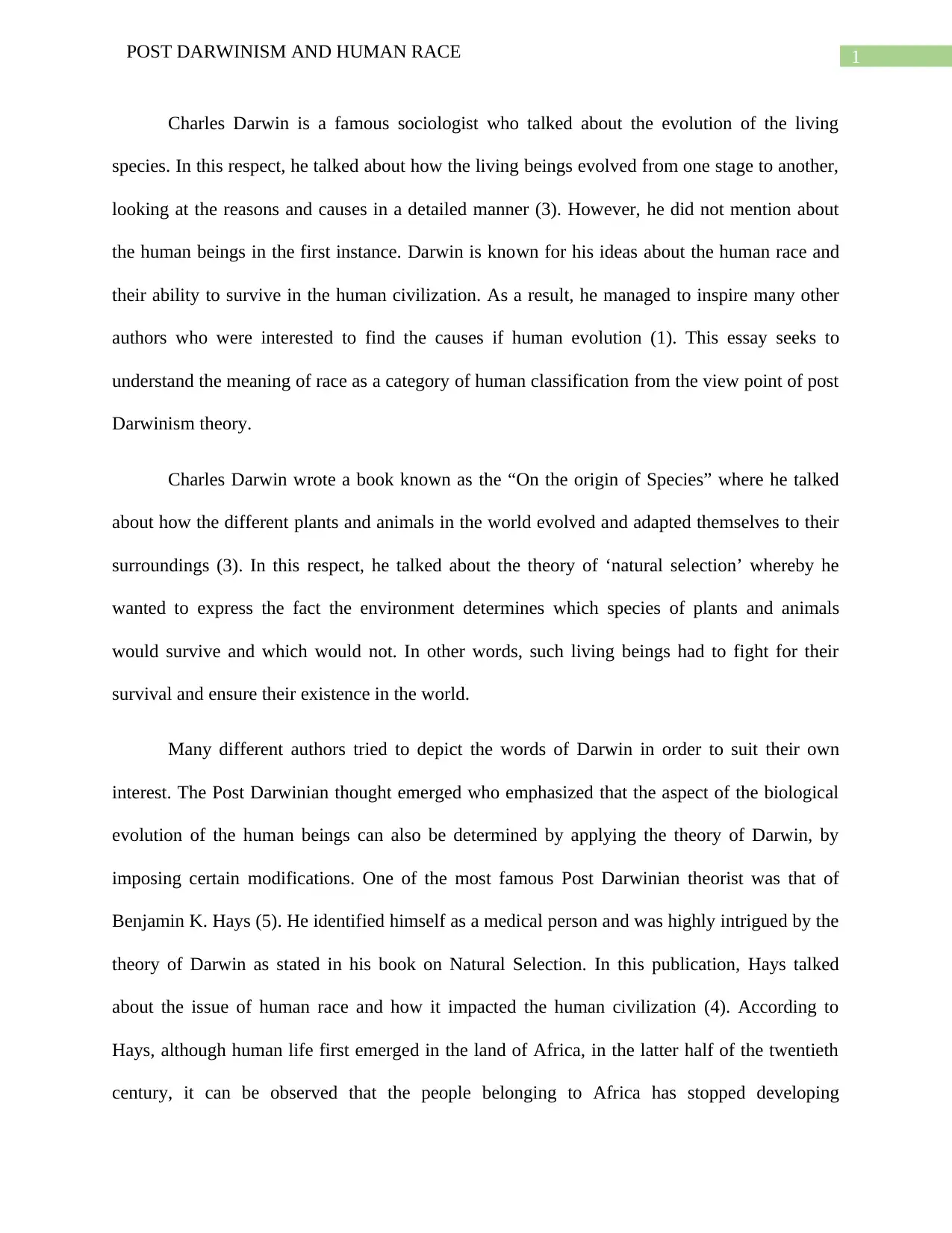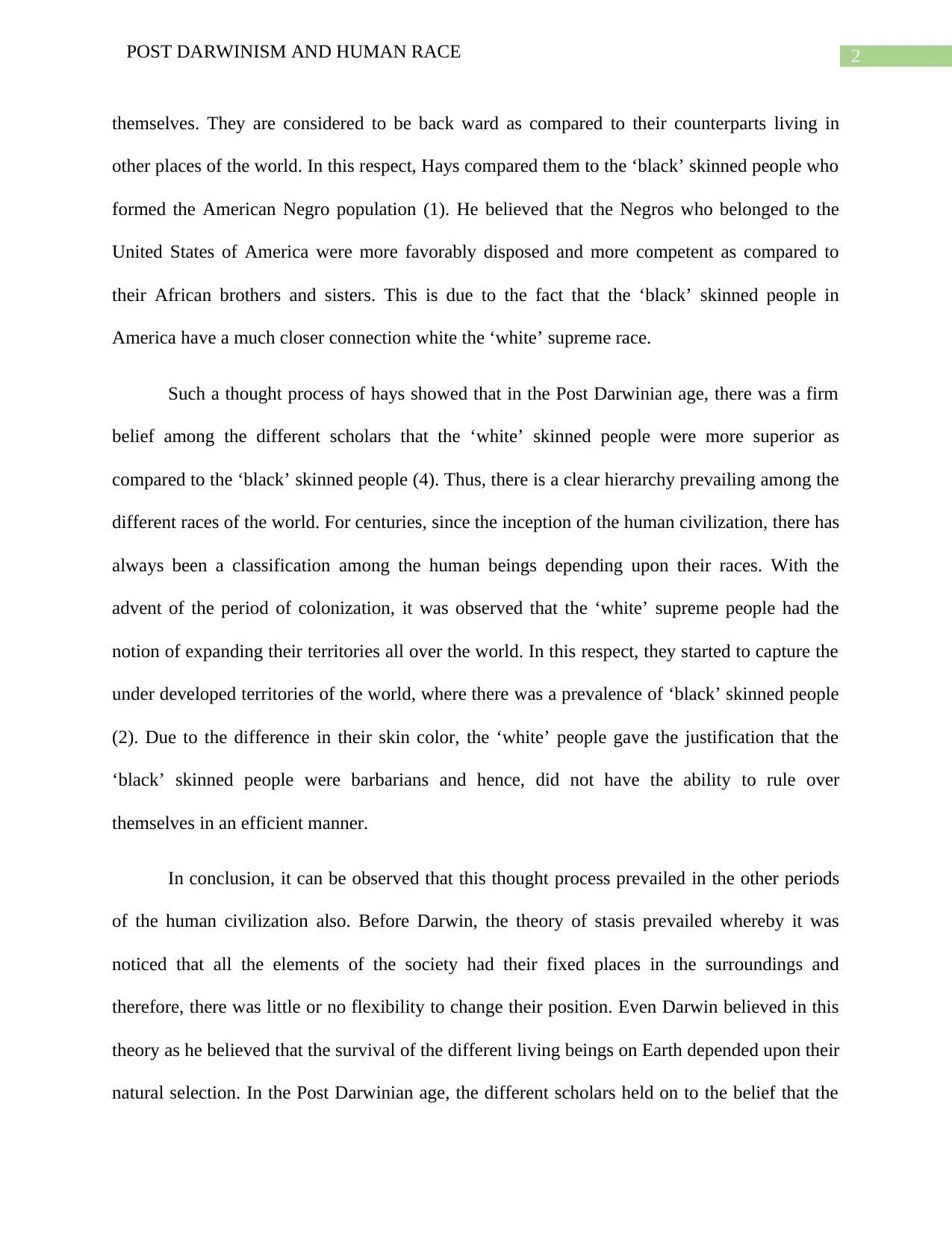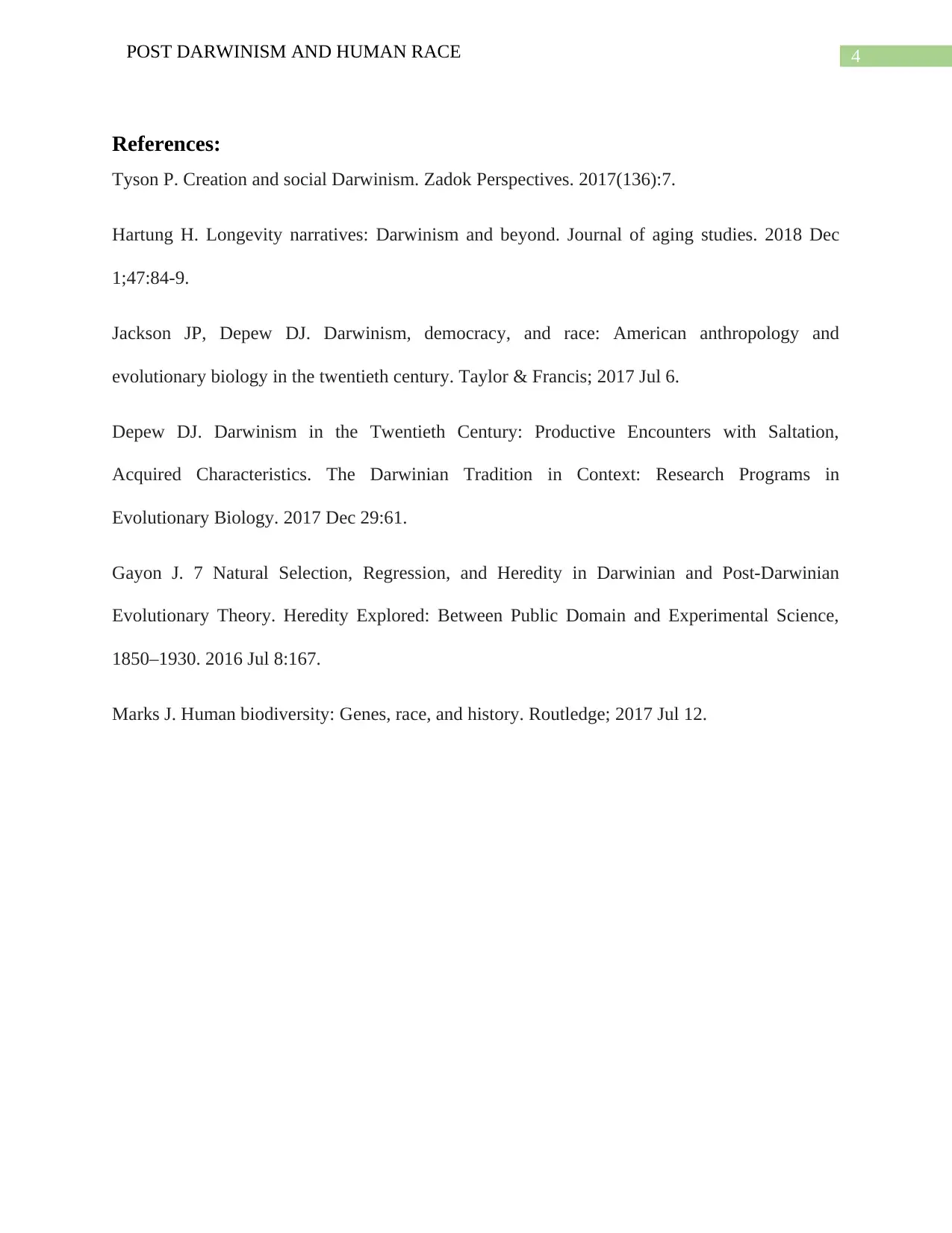University Essay: Post Darwinism and the Human Race
VerifiedAdded on 2022/12/26
|5
|1064
|82
Essay
AI Summary
This essay explores the concept of race through the lens of Post-Darwinism, examining how Charles Darwin's theories of evolution and natural selection influenced the classification of human beings. It discusses the ideas of Darwin and how they were interpreted by subsequent scholars, including Benjamin K. Hays, to understand the evolution and survival of the human race. The essay highlights the emergence of Post-Darwinian thought, which applied Darwin's theories to human biology, and the resulting hierarchies that developed among different races. It also delves into the historical context of racial classification, colonization, and the justifications used by dominant groups. The essay concludes by emphasizing the lasting impact of these ideas on the understanding of human diversity and societal structures. The essay also references sources that support the claims and arguments presented in the text.

Running head: POST DARWINISM AND HUMAN RACE
Post Darwinism and Human race
Name of the Student
Name of the University
Author Note
Post Darwinism and Human race
Name of the Student
Name of the University
Author Note
Paraphrase This Document
Need a fresh take? Get an instant paraphrase of this document with our AI Paraphraser

1POST DARWINISM AND HUMAN RACE
Charles Darwin is a famous sociologist who talked about the evolution of the living
species. In this respect, he talked about how the living beings evolved from one stage to another,
looking at the reasons and causes in a detailed manner (3). However, he did not mention about
the human beings in the first instance. Darwin is known for his ideas about the human race and
their ability to survive in the human civilization. As a result, he managed to inspire many other
authors who were interested to find the causes if human evolution (1). This essay seeks to
understand the meaning of race as a category of human classification from the view point of post
Darwinism theory.
Charles Darwin wrote a book known as the “On the origin of Species” where he talked
about how the different plants and animals in the world evolved and adapted themselves to their
surroundings (3). In this respect, he talked about the theory of ‘natural selection’ whereby he
wanted to express the fact the environment determines which species of plants and animals
would survive and which would not. In other words, such living beings had to fight for their
survival and ensure their existence in the world.
Many different authors tried to depict the words of Darwin in order to suit their own
interest. The Post Darwinian thought emerged who emphasized that the aspect of the biological
evolution of the human beings can also be determined by applying the theory of Darwin, by
imposing certain modifications. One of the most famous Post Darwinian theorist was that of
Benjamin K. Hays (5). He identified himself as a medical person and was highly intrigued by the
theory of Darwin as stated in his book on Natural Selection. In this publication, Hays talked
about the issue of human race and how it impacted the human civilization (4). According to
Hays, although human life first emerged in the land of Africa, in the latter half of the twentieth
century, it can be observed that the people belonging to Africa has stopped developing
Charles Darwin is a famous sociologist who talked about the evolution of the living
species. In this respect, he talked about how the living beings evolved from one stage to another,
looking at the reasons and causes in a detailed manner (3). However, he did not mention about
the human beings in the first instance. Darwin is known for his ideas about the human race and
their ability to survive in the human civilization. As a result, he managed to inspire many other
authors who were interested to find the causes if human evolution (1). This essay seeks to
understand the meaning of race as a category of human classification from the view point of post
Darwinism theory.
Charles Darwin wrote a book known as the “On the origin of Species” where he talked
about how the different plants and animals in the world evolved and adapted themselves to their
surroundings (3). In this respect, he talked about the theory of ‘natural selection’ whereby he
wanted to express the fact the environment determines which species of plants and animals
would survive and which would not. In other words, such living beings had to fight for their
survival and ensure their existence in the world.
Many different authors tried to depict the words of Darwin in order to suit their own
interest. The Post Darwinian thought emerged who emphasized that the aspect of the biological
evolution of the human beings can also be determined by applying the theory of Darwin, by
imposing certain modifications. One of the most famous Post Darwinian theorist was that of
Benjamin K. Hays (5). He identified himself as a medical person and was highly intrigued by the
theory of Darwin as stated in his book on Natural Selection. In this publication, Hays talked
about the issue of human race and how it impacted the human civilization (4). According to
Hays, although human life first emerged in the land of Africa, in the latter half of the twentieth
century, it can be observed that the people belonging to Africa has stopped developing

2POST DARWINISM AND HUMAN RACE
themselves. They are considered to be back ward as compared to their counterparts living in
other places of the world. In this respect, Hays compared them to the ‘black’ skinned people who
formed the American Negro population (1). He believed that the Negros who belonged to the
United States of America were more favorably disposed and more competent as compared to
their African brothers and sisters. This is due to the fact that the ‘black’ skinned people in
America have a much closer connection white the ‘white’ supreme race.
Such a thought process of hays showed that in the Post Darwinian age, there was a firm
belief among the different scholars that the ‘white’ skinned people were more superior as
compared to the ‘black’ skinned people (4). Thus, there is a clear hierarchy prevailing among the
different races of the world. For centuries, since the inception of the human civilization, there has
always been a classification among the human beings depending upon their races. With the
advent of the period of colonization, it was observed that the ‘white’ supreme people had the
notion of expanding their territories all over the world. In this respect, they started to capture the
under developed territories of the world, where there was a prevalence of ‘black’ skinned people
(2). Due to the difference in their skin color, the ‘white’ people gave the justification that the
‘black’ skinned people were barbarians and hence, did not have the ability to rule over
themselves in an efficient manner.
In conclusion, it can be observed that this thought process prevailed in the other periods
of the human civilization also. Before Darwin, the theory of stasis prevailed whereby it was
noticed that all the elements of the society had their fixed places in the surroundings and
therefore, there was little or no flexibility to change their position. Even Darwin believed in this
theory as he believed that the survival of the different living beings on Earth depended upon their
natural selection. In the Post Darwinian age, the different scholars held on to the belief that the
themselves. They are considered to be back ward as compared to their counterparts living in
other places of the world. In this respect, Hays compared them to the ‘black’ skinned people who
formed the American Negro population (1). He believed that the Negros who belonged to the
United States of America were more favorably disposed and more competent as compared to
their African brothers and sisters. This is due to the fact that the ‘black’ skinned people in
America have a much closer connection white the ‘white’ supreme race.
Such a thought process of hays showed that in the Post Darwinian age, there was a firm
belief among the different scholars that the ‘white’ skinned people were more superior as
compared to the ‘black’ skinned people (4). Thus, there is a clear hierarchy prevailing among the
different races of the world. For centuries, since the inception of the human civilization, there has
always been a classification among the human beings depending upon their races. With the
advent of the period of colonization, it was observed that the ‘white’ supreme people had the
notion of expanding their territories all over the world. In this respect, they started to capture the
under developed territories of the world, where there was a prevalence of ‘black’ skinned people
(2). Due to the difference in their skin color, the ‘white’ people gave the justification that the
‘black’ skinned people were barbarians and hence, did not have the ability to rule over
themselves in an efficient manner.
In conclusion, it can be observed that this thought process prevailed in the other periods
of the human civilization also. Before Darwin, the theory of stasis prevailed whereby it was
noticed that all the elements of the society had their fixed places in the surroundings and
therefore, there was little or no flexibility to change their position. Even Darwin believed in this
theory as he believed that the survival of the different living beings on Earth depended upon their
natural selection. In the Post Darwinian age, the different scholars held on to the belief that the
⊘ This is a preview!⊘
Do you want full access?
Subscribe today to unlock all pages.

Trusted by 1+ million students worldwide

3POST DARWINISM AND HUMAN RACE
white’ skinned people were more advanced and competent that the ‘black’ skinned people.
Furthermore, according to Hays, the people living in Africa were at a disadvantage as they did
not have any communication with the ‘white’ skinned people. This showed that it was necessary
for the ‘black’ race to be near the proximity of the ‘white’ race in order for them to be more
developed.
white’ skinned people were more advanced and competent that the ‘black’ skinned people.
Furthermore, according to Hays, the people living in Africa were at a disadvantage as they did
not have any communication with the ‘white’ skinned people. This showed that it was necessary
for the ‘black’ race to be near the proximity of the ‘white’ race in order for them to be more
developed.
Paraphrase This Document
Need a fresh take? Get an instant paraphrase of this document with our AI Paraphraser

4POST DARWINISM AND HUMAN RACE
References:
Tyson P. Creation and social Darwinism. Zadok Perspectives. 2017(136):7.
Hartung H. Longevity narratives: Darwinism and beyond. Journal of aging studies. 2018 Dec
1;47:84-9.
Jackson JP, Depew DJ. Darwinism, democracy, and race: American anthropology and
evolutionary biology in the twentieth century. Taylor & Francis; 2017 Jul 6.
Depew DJ. Darwinism in the Twentieth Century: Productive Encounters with Saltation,
Acquired Characteristics. The Darwinian Tradition in Context: Research Programs in
Evolutionary Biology. 2017 Dec 29:61.
Gayon J. 7 Natural Selection, Regression, and Heredity in Darwinian and Post-Darwinian
Evolutionary Theory. Heredity Explored: Between Public Domain and Experimental Science,
1850–1930. 2016 Jul 8:167.
Marks J. Human biodiversity: Genes, race, and history. Routledge; 2017 Jul 12.
References:
Tyson P. Creation and social Darwinism. Zadok Perspectives. 2017(136):7.
Hartung H. Longevity narratives: Darwinism and beyond. Journal of aging studies. 2018 Dec
1;47:84-9.
Jackson JP, Depew DJ. Darwinism, democracy, and race: American anthropology and
evolutionary biology in the twentieth century. Taylor & Francis; 2017 Jul 6.
Depew DJ. Darwinism in the Twentieth Century: Productive Encounters with Saltation,
Acquired Characteristics. The Darwinian Tradition in Context: Research Programs in
Evolutionary Biology. 2017 Dec 29:61.
Gayon J. 7 Natural Selection, Regression, and Heredity in Darwinian and Post-Darwinian
Evolutionary Theory. Heredity Explored: Between Public Domain and Experimental Science,
1850–1930. 2016 Jul 8:167.
Marks J. Human biodiversity: Genes, race, and history. Routledge; 2017 Jul 12.
1 out of 5
Related Documents
Your All-in-One AI-Powered Toolkit for Academic Success.
+13062052269
info@desklib.com
Available 24*7 on WhatsApp / Email
![[object Object]](/_next/static/media/star-bottom.7253800d.svg)
Unlock your academic potential
Copyright © 2020–2025 A2Z Services. All Rights Reserved. Developed and managed by ZUCOL.



